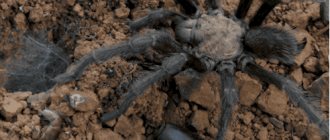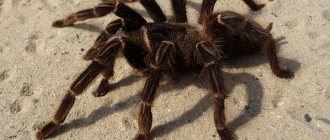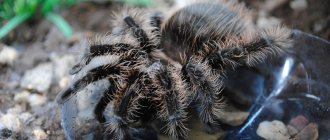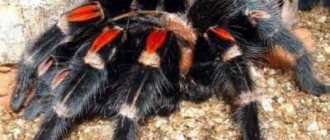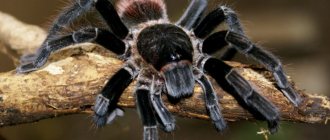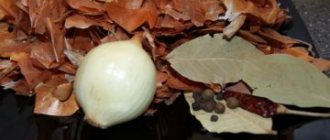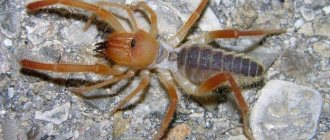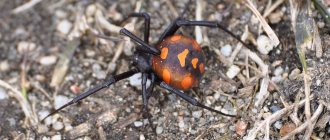Spiders 08/07/20206102 views
Poecilotheria metallica is rightfully considered one of the most beautiful and rare tarantula spiders. The dream of many keepers is to have this species in their collection. The habitat area, judging by a few literary sources, is in the South-South-East of India (Gooty, Madras), but it is not clearly defined and has gaps due to human economic activity and the destruction of natural habitats.
Terrarium 30*30*30 cm PetPetZone (spider)
The body structure is characteristic of all representatives of the genus. Adult sizes range from 15 to 21 cm in paw span. Females are more massive, however, in habit, as a rule, they are smaller before adult molt. The coloring is very bright, metallic blue with gray-white patterns on the carapace and abdomen, and on the legs, especially on their back side, there are also yellow stripes. Individuals from the southern range have a black carapace, because of this there is an opinion about two color variations. The intense blue coloration is most pronounced in subadult males. Females are less intensely colored throughout their lives. One of the nice things about metallics is the absence of irritating hairs.
Spreading
The metallic tree tarantula is found only in the state of Andhra Pradesh in India in the vicinity of the cities of Nandyal and Giddaluru.
The total area of its habitat does not exceed 100 square kilometers. The animal was first discovered in the bungalow of a railway engineer on the northwestern line of the Madras Railway in the town of Gooty, located a hundred miles from its habitat. Presumably it got there after traveling on a train. Subsequently, he was never found in this area again.
The caught specimen was described in 1899 by British arachnologist Reginald Pocock. For a long time, the species was considered extinct, until 102 years later it was found again in the jungle by Canadian zoologist Rick West and British naturalist Andrew Smith. The local population calls it a blue or blue spider.
Pecilotheria metallica is included in the list of the 100 most endangered species of the world's flora and fauna.
Types of tarantulas
The spider family includes many representatives, including 13 subfamilies with a large number of varieties. In total, scientists count about 143 species of tarantulas. All of them have characteristic features, but some varieties are distinguished by their original appearance, and therefore are worthy of a detailed description.
Goliath tarantula
This animal has become widely known due to its impressive size. Taking into account the legs, the body length reaches 28 cm. Until recently, the goliath was considered the largest spider on the planet. But at the very beginning of the 21st century, Heteropoda maxima was discovered - a species belonging to the same order, the body size is a couple of centimeters larger than that of the goliath.
Black and white Brazilian tarantula spider
The animals are inferior in size to the goliath, body length is no more than 23 cm. Distinctive features are rapid growth and striking black and white color. The nature of the spider is aggressive and unpredictable. Often arthropods hide under the roots of trees or among stones, and from time to time they crawl out into the open.
Metallic (woody) tarantula
Distributed in the southern regions of India. Among its relatives, this representative does not stand out at all in size, since it grows only up to 21 cm. Its color is very interesting - the body and legs are bright blue with a metallic tint, as if decorated with fascinating patterns
The spider looks like some kind of fantastic creature that attracts attention with its extraordinary beauty
Metallic tarantulas prefer to form small groups and settle among old rotten trees.
Brachypelma Smitha
Found in Mexico, South America and Australia. The size of spiders does not exceed 17 cm. The colors can be varied: dark brown or black with the addition of orange and red tones, sometimes there is a white or yellow border. The hair on the body turns light pink.
Smith's brachypelma are calm in nature and their venom is non-toxic. As they grow older, after molting, the color of the spiders changes.
Pink Chilean tarantula
This species of arthropod is considered one of the most attractive. It is not surprising that this is what arachnid lovers dream of having at home.
The size of the body together with the paws reaches 26 cm. The color contains various shades of brown: brown, chestnut, and in places there are pink hairs. A lot of light hairs grow on the paws and body.
a brief description of
The tarantula is a spider, part of the group of arthropods, which has an exotic appearance. The main distinguishing feature of the arachnid representative is its large body size. Lives everywhere, found in countries with tropical climates.
The representative lives in burrows, on the ground, in bushes, and in trees. He prefers to be invisible, so he often hides, this allows him to easily catch prey. H
It often happens that nymphs initially live underground, and when they reach adulthood they move to the trees. Spiders are slow, making sudden movements when absolutely necessary. Well-fed females may not leave their homes for several months.
The characteristics of spiders include:
- The size of the spider's body ranges from 4 to 7 cm. During the span of the legs, it reaches 12-18 cm.
- the tarantula weighs from 60 to 100 grams;
- The body color of an arthropod can be varied; it fascinates with its iridescence, richness and brightness. There are representatives of this species with blue, green, monochrome black, rich yellow, emerald and other colors;
- the spider has a chitinous shell. After molting, it acquires the brightest color;
- On the surface of the insect's body there are hairs that perform a protective function. The insect can use them to weave nets. The hairs on the abdomen are poisonous;
- nature awarded the representative of this species with six pairs of legs. Four of them are the main limbs. The rest are chelicerae and pedipalps.
Despite the name, the arachnid is rarely satisfied with meat. He prefers lighter and more accessible food.
His diet consists:
- flies, crickets, locusts, cockroaches, grasshoppers and other insects;
- spiders;
- worms;
- frog;
- snake;
- fish fry;
- naked mice;
- chicks.
Males reach sexual maturity at 1-2 years, and females at 2-5 years. Before the mating season, males weave nets from cobwebs, onto which seminal fluid is applied.
During the mating season, the spider collects seminal fluid into a sac - the cymbium - and crawls towards the female. Using hooks, he holds her sexual organ and fills it with sperm, which is how fertilization occurs. After 1-8 months, the female forms a cocoon from the web, where she lays eggs.
It is worth considering that tarantulas are a group that unites various species of spiders. They have interesting features and distinctive qualities. Some of them are even used to maintain houses.
Lampropelma violaceopes
Special data of this type include the following facts:
- a large individual, at maturity reaching up to 9 cm in body length and up to 25 cm in paw span;
- can lead both burrowing and arboreal types of life;
- The color of the female is clearly expressed in blue-violet tones, which becomes more saturated with each molt;
- leads a nocturnal lifestyle;
- feeding mainly consists of hunting insects.
An extremely aggressive and fast spider, this pet is not suitable for novice keepers.
Cyriopagopus schioedtei
Cyriopagopus, a Malaysian species of tarantula, is quite rare in amateur collections due to its aggressiveness and difficulties in breeding. On sale it has a high price. The main features of this type include:
- the type of life is burrowing, and the individual can burrow to a depth of up to 7 cm;
- general body parameters can reach up to 8 cm with a paw span of up to 25 cm in males;
- The species grows quickly and sexual maturity occurs in males within a year, in females after 1.5 - 2 years.
The general temperature of such an individual should not drop below 24°C, with a total humidity of up to 85%. It is advisable to equip the terrarium with a sufficient amount of soil.
Poecilotheria metallica
Probably the most beautiful and rarest species of spider. The bright blue color with a beautiful ornament along the torso attracts the attention of many arachnid lovers.
But it is worth considering that the temper of this species is very aggressive, and if you add to it the high speed of reactions, then only professionals can have such a pet. General data of Poecilotheria metallica are as follows:
- body size can reach up to 8 cm with a limb span of up to 18 cm;
- the total lifespan of such a spider is about 15 years;
- leads an arboreal lifestyle, living on the treetops of the tropical forests of India;
- the temperature of keeping such a pet should not fall below 23°C, with humidity up to 80%.
Tarantula spider Petsiloteriya metallika
The species does not reproduce often in captivity; before mating, the male can stay with the female for some time without the danger of being eaten. If fertilization has occurred, then after a couple of months the female makes a cocoon, which can contain from 100 to 160 nymphs. The incubation period is about 2 months.
Unfortunately, almost all blue tarantula spiders have a strong toxic venom, and its bite can lead to allergic reactions, pain, nausea, dizziness and fever.
It is recommended to carry out any manipulations in the terrarium using long tweezers. Children and other pets should not be allowed near the blue tarantula.
But with a competent approach, proper maintenance and attentiveness of the owner, these species can add a great advantage to the entire collection.
How to avoid being bitten?
To avoid being bitten by such a spider, you should carefully monitor its behavior. The spiders themselves are quite peaceful and never attack first. Before biting, they hiss demonstratively and raise their front or hind legs. Often the attack occurs due to the carelessness of the owners themselves. Here are some tips to help avoid such cases:
- You should not act with an animal if they behave aggressively: they hiss and raise their front paws.
- You should not touch the female while the kokan is forming. In general, females are believed to be more aggressive than males. Spiders can behave aggressively during the period before and after mating.
- You should not touch the spider during molting, as the animal is most aggressive during this period.
- To make your pet more friendly, you should follow a special diet. Although spiders are fairly unpretentious eaters, their diet should be controlled not only to maintain their health, but also to increase their lifespan.
- It should be remembered that the tarantula is a dangerous and predatory creature, and you should not take it as a pet if you are unsure of its abilities. You should not get such a pet if you feel fear or disgust towards the animal.
Important! After any contact with an arachnid, you should wash your hands thoroughly. Avoid contact with spiders while eating or cooking.
Where do they live?
Under natural conditions, these spiders are active at night, and during the day they hide in the crowns of trees. Also, young individuals often make homes for themselves at the base of a tree in earthen burrows, disguising them with cobwebs. Blue spiders live mainly in groups.
Help! The venom of these arthropods is potent. A human bite from an adult can lead to various allergic reactions, headaches, nausea, dizziness and fever.
Poecilotheria ornata bite, consequences, report:
After being bitten on the finger by an adult female Poecilotheria ornata, Igor felt pain and a burning sensation that lasted about 2 hours, the finger was noticeably swollen. Then everything began to pass, Igor went to bed.
I woke up in a state of “hangover”; after a while my arm began to cramp, pain began to spread to my shoulder and other arm. I felt dizzy and my legs began to cramp.
During the day, Igor felt sleepy, swayed greatly, it felt as if he had been sitting on an uncomfortable chair for a long time, and suddenly stood up, his legs cramped. The body temperature was about 38 degrees, the muscles were twitching every now and then.
The next night, Igor could not sleep for a long time, and upon awakening he felt weak, but his condition returned to normal.
Nutrition
Blue arthropods are predators. They do not feed on birds; the basis of their diet consists of grasshoppers, larvae of various insects, other smaller spiders and beetles, small frogs, locusts, etc. The spider's food does not exceed it in size; it does not dare to attack large prey. These predators do not use the web for hunting, but simply attack the prey. Having overtaken the prey, it injects poison into it, which paralyzes the victim’s body. Then it weaves a web around the insect and releases stomach acid into the immobilized body. After a short period of time, the insides of the prey soften and the predator begins to feed.
Eight point crab spider
This representative of the side-walking spiders has a bright yellow color. There are four small black spots on the cephalothorax, and seven more black spots are on the elongated and slightly flat abdomen. The long legs are also colored yellow, and their last segment is black or transparent (in males).
Sidewalkers live in Southeast Asia, on the islands of Java and Sumatra. Their females are much larger. They reach about two centimeters in size, while males grow only up to 4 mm. The provocative color is needed by spiders to camouflage themselves as a flower, sitting on which predators wait for wasps and other insects.
Behavior in the wild
The body length of an adult arthropod can reach 50 mm. At the same time, the dimensions of the Avikami’s body are 23 mm in length and 20 mm in width. The length of the legs is 50 mm. Arthropods choose Indian tropical forests as their habitat.
They are not afraid of changes in climate, air temperature and humidity levels. This species is able to adapt to any environment. The main characteristics of a spider are the following:
- the insect hunts only at night;
- lifestyle - solitary. Spiders can eat each other. This is why in the wild, insects are 1 meter apart from each other;
- Deciduous trees are considered the favorite habitat of spiders, where arthropods can hide from the heat in the hollow or bark of trees;
- The diet of each spider includes small reptiles, insects, frogs and everything that gets caught in the web.
When danger approaches, tarantulas flee. If all possible paths are cut off, the spider can attack without using poison.
Genus Poecilotheria feeding:
Feeding tarantula spiders of this genus is very banal, food objects should be selected the size of the spider’s body (without taking into account the length of the legs), adults can be fed once every 1-1.5 weeks, babies once every 3-4 days.
Madagascar, marbled, Turkmen, Argentinean, six-spotted and other feeding cockroaches, crickets, locusts, zofobas larvae, and mealworms are perfect for food.
Appetite problems in representatives of the genus Poecilotheria usually do not occur; if a tarantula refuses to eat, take a closer look at it, perhaps it is preparing for molting or is in a state of stress. It will also cope with food refusal, sometimes changing food items helps, we must not forget that these spiders lead an arboreal lifestyle, they will be more accustomed to catching locusts or crickets than zofobas larvae.
You can read more about feeding tarantula spiders here: “Feeding tarantula spiders”, and tips and information about feeding younger tarantula spiders here: “Feeding younger tarantula spiders”.
Danger to humans
All tarantula spiders are poisonous. If they talk about a safe animal, this means poison of low toxicity. There are no officially registered cases of human death from a bite. However, there is information that cats have died from pets. Often the bite occurs dry - without injecting poison. Then only a small hematoma remains at the site of the attack.
An allergic reaction to a toxic substance depends on the state of the immune system and age. Spider bites are potentially dangerous for children, people prone to allergic reactions, and the elderly. Possible consequences are local skin allergies, breathing difficulties, muscle spasms, vomiting, abdominal pain, weakness, dizziness.
In natural conditions, spiders shed poisonous fibers when there is a threat to their own lives, and weave them into the web when forming a cocoon with eggs or a nest. In the terrarium, the tarantula sheds its lint due to stress. Inhaling them leads to the development of allergies - rhinitis, cough, shortness of breath, difficulty breathing, lacrimation, etc.
At home, tarantulas are kept in terrariums and fed with insects. It is impossible to train or accustom spiders to anything.
Sources
- https://zooclub.org.ua/pauki/15902-metallicheskij-drevesnyj-pticeed-ili-peciloteriya-metallika.html
- https://parazitdoma.ru/drugie-parazity/siniy-pauk
- https://animalgid.ru/pauk-ptitseed/kakie-harakteristiki-imeet-sinij-ptitseed.html
- https://jivotina.com/pauk/goluboj-pticeed/
- https://zveryatnik.ru/pauk-pticeed/kak-razmnozhaetsya-metallicheskij-drevesnyj-ptitseed.html
- https://apest.ru/pauki/vidy-paukov/pauki-ptitseedy/
[collapse]
Content:
It doesn't take much to successfully maintain metallics. You need a spacious vertical terrarium, approximately 30x30x40. Large sizes are needed not so much by the spider as to protect itself from a bite. You can add various decorative elements. The temperature should be no lower than 23 degrees, and the humidity should be about 80%. I would also like to add that Poecilotheria metallica is one of the few tarantulas that look the same in real life as they do in photographs, and the metallic blue coloring of their body really makes all owners of this tarantula admired.
Terrarium 30*30*30 cm (25 liters) (spider)
Author: Artem Zenkevich Editor: Tatyana Potapenko Source: [[https:/https://planetexotic.ru/]
Family name
origin of name
One of the ancient engravings, the image on which served as the basis for the name - tarantula
The name “tarantula spiders” arose as a result of several engravings drawn by the German researcher and animal painter Maria Sibylla Merian and published as a result of her stay in Suriname (1699-1701) in the work “Metamorphosis insectorum Surinamensium” (1705), where she observed like a large tarantula ( Avicularia sp.
) attacked the hummingbird in the nest.
Problems with the translation of the term
In a number of European languages, tarantulas, and sometimes all large spiders, are often called tarantula. In Russian, the word tarantula is used to designate spiders of a slightly different group, in particular including spiders, which are widespread in the south of Russia. In this regard, confusion often arises when texts are translated incorrectly. In modern biological systematics, the taxa “tarantulas” and “tarantulas” do not overlap; Tarantulas are mygalomorphic spiders, and tarantulas are araneomorphic.
How long will a tarantula spider live in your apartment?
It depends on the gender. Have you decided to buy a female tarantula spider? She can live 10-20 years. And the male dies much earlier: after a year or two of life. The lifespan of a tarantula spider is affected by the conditions that you provide it with:
- temperature in the apartment;
- amount of food and mode of its serving;
- the presence of other animals in the spider’s territory.
If your room is extremely cold, you will get sick and weak. And the tarantula spider is the opposite: it will feel better than ever. A minimum of food will allow him to live longer. And excess is the opposite. This arthropod lives on all continents of our planet. The only exception is Antarctica. The optimal temperature for keeping it is 20 degrees.
Description of the insect
Outwardly, the recluse spider reminds everyone of the familiar harmless haymaker. It has a small body 5-7 mm long and long legs with a span of up to 15-20 mm. It is colored brown, dark yellow or gray. On the cephalothorax there is a pattern similar to a violin.
The hermit has some features that distinguish it from other spiders:
- it has only three pairs of eyes, while other species have four;
- there is no pattern on the abdomen and legs;
- the body is covered with hairs;
- the web is sticky, chaotic, without the usual radial structure.
The arthropod received the name “hermit” due to its solitary lifestyle. It does not spread webs between trees or on grass. During the day, the spider hides in inaccessible dry places: under stones, snags, in crevices, in burrows of small animals, and only comes out to hunt at night.
This video explains the characteristics of the recluse spider:
It is not attached to its web and can move quite far from the nest. The brown recluse looks for other spiders and other insects, attacks them and injects poison, which instantly kills them. Spider venom is very toxic; its composition has not been fully studied.
Spiders make nests in hidden, hard-to-reach places. They spin cocoons and lay eggs in them. There are up to 40-50 eggs in one cocoon. The spider reliably guards the clutch and practically does not leave the nest until the offspring appear. As they grow, young spiders change their shell up to 8 times. The lifespan of hermits is 2−4 years, some individuals live up to 6 years.
https://youtube.com/watch?v=EHrWEmxEdxE
Reproduction process
After the onset of monsoons in the southwest, adults moult. The process is directly influenced by the rainy season and air masses. The molting period lasts until September and the breeding process begins immediately.
Typically, females do not show strong aggression towards their partners. That is why the mating process occurs without victims. After crossing a quarter, the female creates a cocoon, in which up to 150 eggs later appear.
Young individuals are born in February and begin to compete with each other. Each spider exhibits cannibalistic tendencies. As a rule, the weakest, not fully formed individuals die first.
At the end of April and beginning of May, the mature larvae leave the nest. The spiders return to earth, where they spend all their time until they reach adulthood. Later, adults move to trees.
